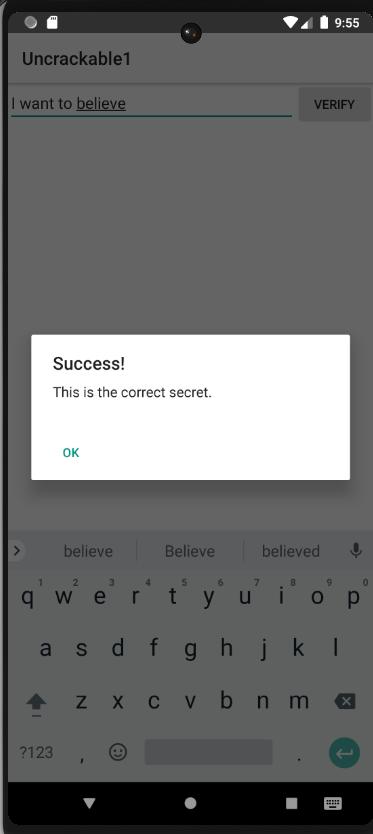Uncrackable1
This android challenge is part of a series of challenges offered by OWASP Mobile Application Security
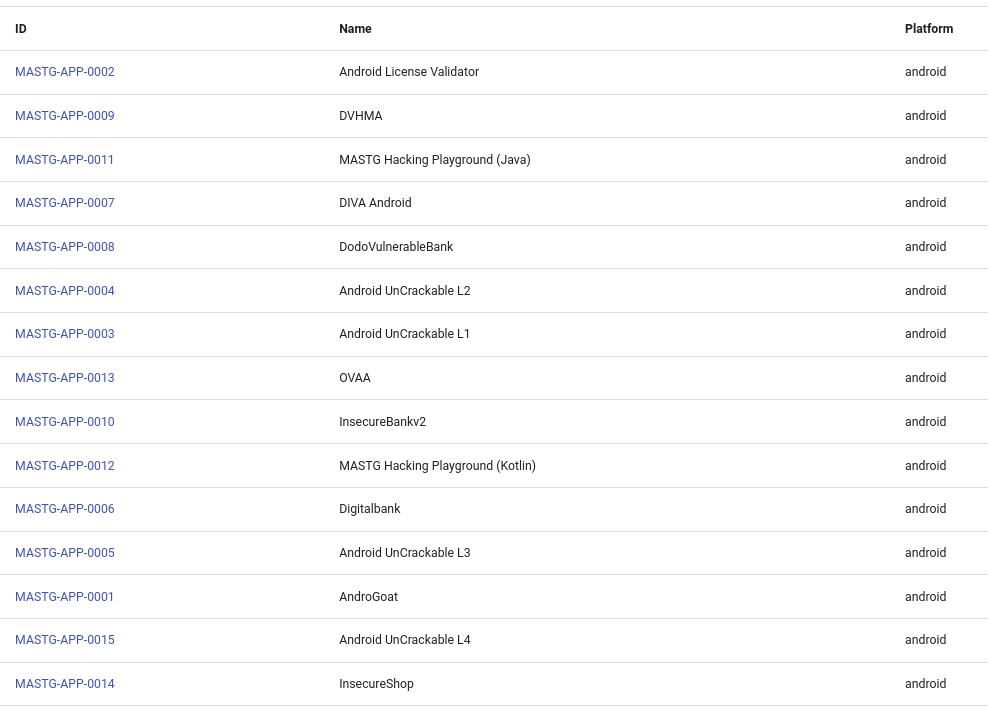
In this one, the flag is a secret string hidden in the app.
Understanding the app
First of all, let’s take a look at the application.

In the background, it seems like there is text field that’s waiting for the secret string. That’s probably where we should type the flag.
However, it also looks like the app detected that my emulator is rooted.
Let’s go with our good old mate Jadx !
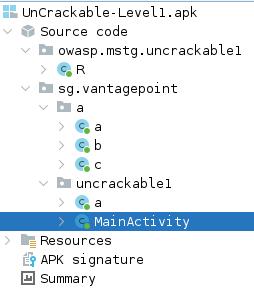
The dex file is much obfuscated, so it should ease our way to the flag.
First, let’s see the manifest.

First thing we can notice, and that could be useful in the future, is the package name : owasp.mstg.uncrackable1
Secondly, we can see that the activty that the application “starts” with the activity named sg.vantagepoint.uncrackable1.MainActivity** because it contains the tag <action android:name="android.intent.action.MAIN"/> that indicates which activity is considered as the entry point.
⚠ WARNING: Even though there is an Activity called “MainActivity”, it doesn’t mean that’s the entry point. Indeed, malwares can trick us by using another activity as the entry point. So, check the manifest !
MainActivity is pretty straight forward :
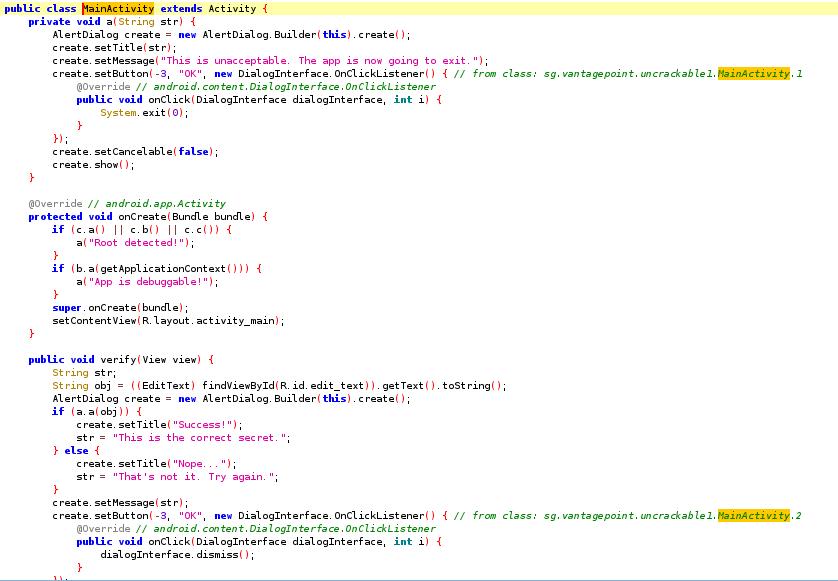
There is a verify method that obviously checks our input and matches it with the secret string.
The root detection is done in onCreate and then MainActivity.a is potentially called to disallow us from using the app.
Finding the secret string
verify calls a.a with the user input as an argument.
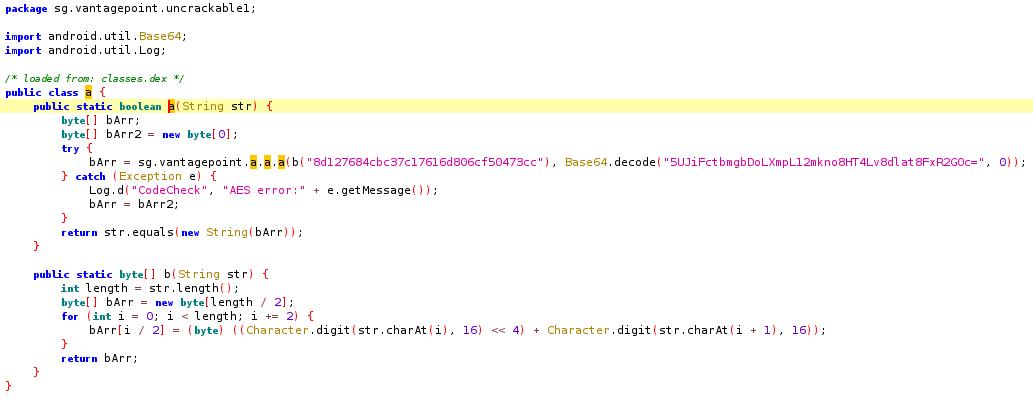
a.a does a few thing :
- First it calls
a.bwith the string8d127684cbc37c17616d806cf50473ccas an argument - Then it calls
a.a.awith the value returned bya.bat the first step and5UJiFctbmgbDoLXmpL12mkno8HT4Lv8dlat8FxR2GOc=decoded as base64. - Finaly, the value returned by
a.a.ais compared to the user input.
We can immediatly see that a.b only converts the argument from an hexadecimal representation to a byte array.
Now, we can get into a.a.a :
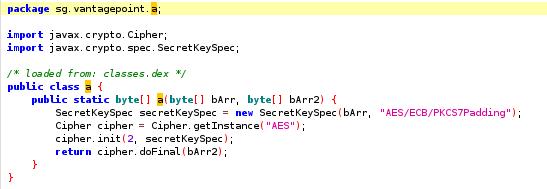
Well, a bit disapointing…
It’s only an AES decryption in ECB mode. The first parameter is the key, and the second one is the ciphertext.
Let’s use a small python script to decrypt it : 8d127684cbc37c17616d806cf50473cc
from Crypto.Cipher import AES
from Crypto.Util.Padding import unpad
import base64
ciphertext="5UJiFctbmgbDoLXmpL12mkno8HT4Lv8dlat8FxR2GOc="
ciphertext = base64.b64decode(ciphertext)
key="8d127684cbc37c17616d806cf50473cc"
key = bytes.fromhex(key)
cipher = AES.new(key, AES.MODE_ECB)
plaintext = cipher.decrypt(ciphertext)
print(plaintext.decode('utf-8'))
And we get the potential secret string : I want to believe
Let’s believe
Now, we have to bypass the root detection because I am too lazy to download another AVD that’s not rooted.
We saw that MainActivity.a is the annonying method that prevents us from verifying the flag.
Let’s use frida, in order to reimplement this method making it useless.
The frida script is pretty simple :
Java.perform(function() {
const badMethod = Java.use("sg.vantagepoint.uncrackable1.MainActivity").a.overload("java.lang.String");
badMethod.implementation = function(str){
console.log("Bypassing MainActivity.a");
return;
//return badMethod.call(this,str);
}
});
First we put a hook on this method (badMethod), and we make it print a message. Then, it returns nothing instead of badMethod.call(this,str) (which would execute the original code).
We then make frida spawn the app (instead of attaching to it later because it would be to late as onCreate would already have been executed).
┌──(devilsharu㉿Kali)-[~/Documents/OWASP-Mobile]
└─$ frida -U -f owasp.mstg.uncrackable1 -l uncrack1.js
Now, we can believe !
